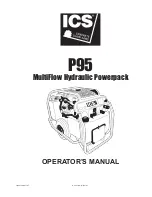
7
12. If needed, adjust the spacing between the bit and
Indexing Key. Unplug the router and loosen one of
the five-star knobs on the Platform (1). If the fit of
your box joints is too tight, nudge the Platform
slightly so that the Indexing Key is closer to the bit.
If the fit is too loose, nudge the Platform to move the
Indexing Key a hair farther from the bit.
Use
1. After setting up the jig for your application, lay out
all four sides of your box with the inside faces up.
Label each piece on the inside face (A, B, C and D)
and mark the top and bottom edges (T and B).
Fig. 6.
2. To make the first cut, position the top edge of
Workpiece A flush against the Indexing Key’s left edge
and hold or clamp it there. Make the cut by sliding
the Sled forward across the bit and then back to the
starting point.
Fig. 7.
You will need to make dedicated MDF
Sacrificial Fences for the other Indexing Keys. Simply cut
a piece of 1/2" thick MDF 3
1
⁄
8
" wide x 6" long and notch it
to allow clearance for each Indexing Key. You can use the
original MDF Sacrificial Fence as a guide for laying out the
notched area.
The Router Table Box Joint Jig is intended
for use in cutting end-grain joints like those shown. Joints
cut across the grain could result in significant tear-out
unless an additional sacrificial backer is used.
Fig. 6
Fig. 7
T
A
> Use only with wood and MDF no more than 1" thick.
> Platform (1) MUST be secured in the router table
miter slot by fully tightening the five-star knobs of
the Miter Slot Hardware (2).
> Indexing Key (4, 5 or 6) and MDF Sacrificial
Fence (7) MUST be securely attached to Sled (3).
> Sled (3) must be able to slide smoothly in
Platform (1) slots.
> Maintain control of the Sled and workpiece at all
times by holding workpiece securely or clamping
the workpiece to the Sacrificial Fence/Sled’s flat
clamping areas.
> If you encounter excessive resistance when
routing, turn off the router immediately and
determine the cause (for example, a dull bit).
> Do NOT attempt to machine more than one
workpiece at a time (for example, by stacking).
THESE WARNINGS PERTAIN
TO ALL REMAINING STEPS:
> To avoid serious injury, keep
hands and fingers away from
rotating cutter.
T
T
B
B
A
T
T
B
B
B
T
T
B
B
C
T
T
B
B
D


























